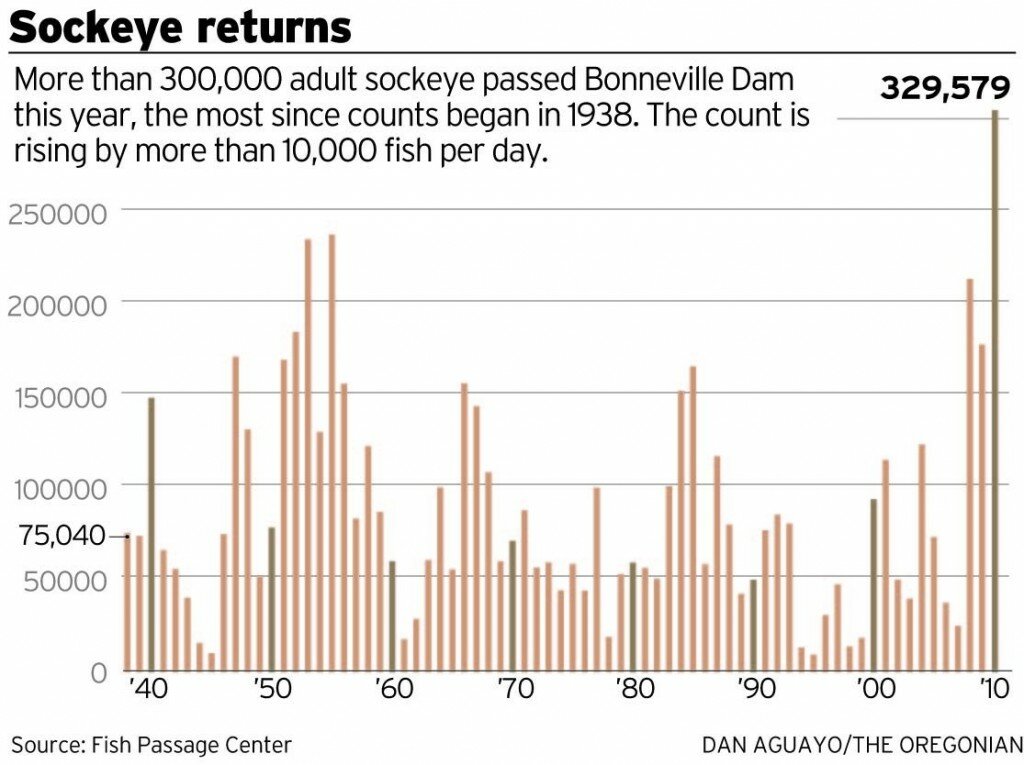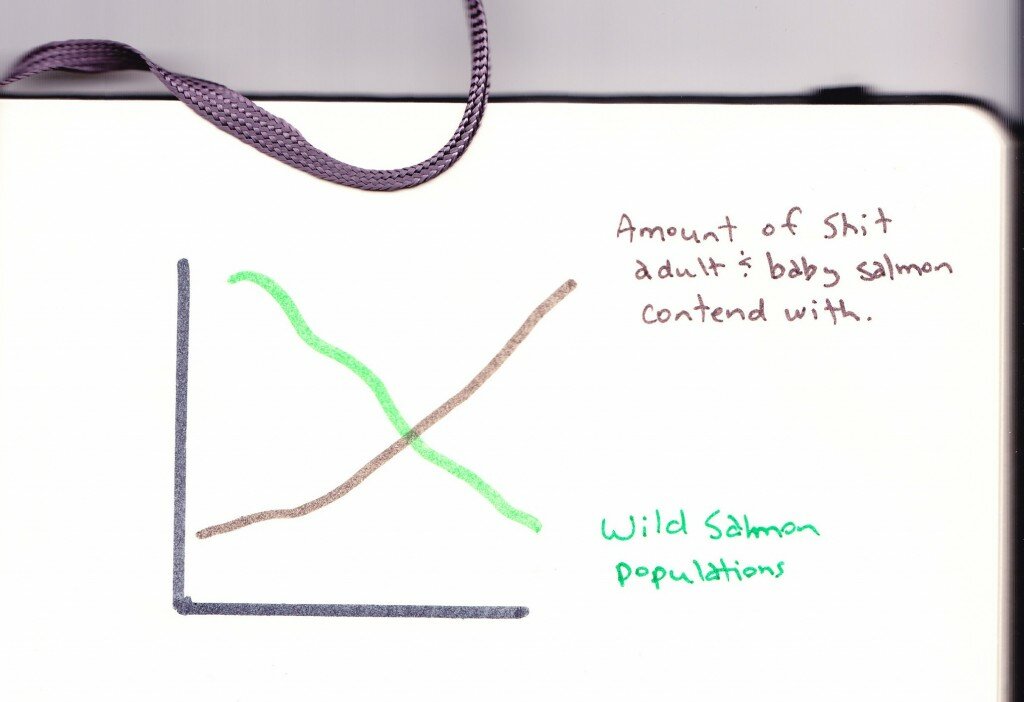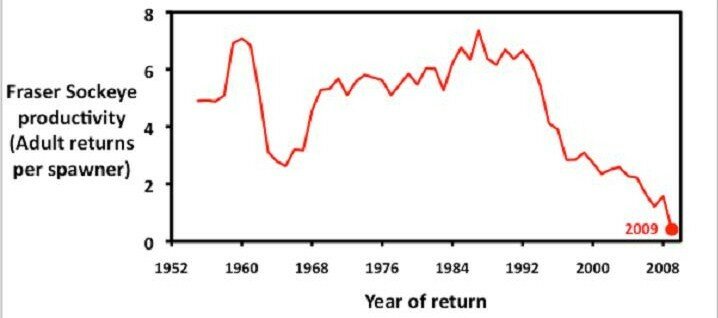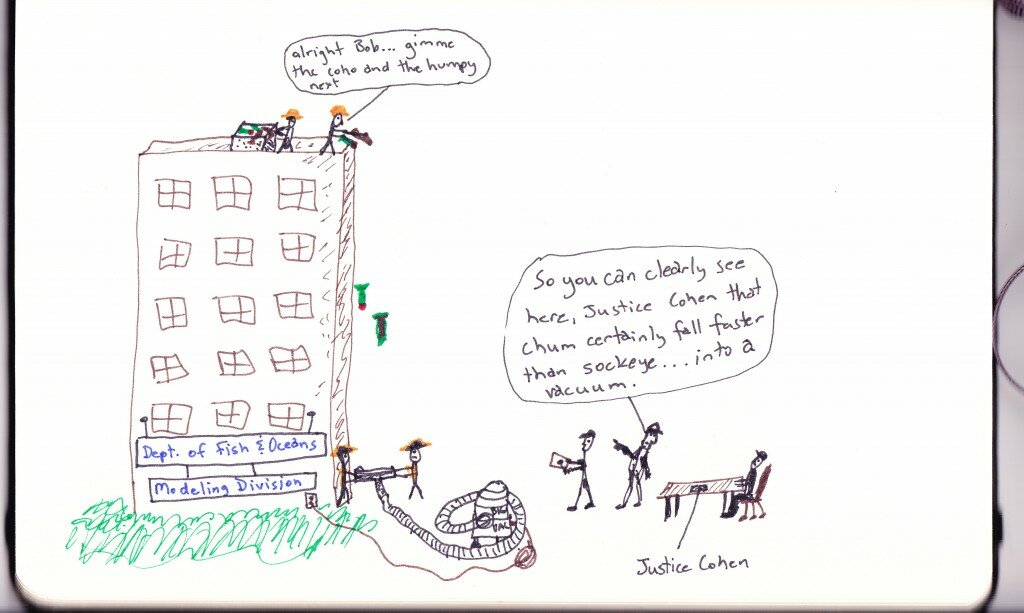“All models — in physics, biology, or economics — simplify reality in order to improve our understanding of it.” So suggests my Economics textbook.
"ANGEL " doll face, toy wings, tape, bathroom scale approx 6 x 12" by Simon Davies
Is it me… or is “simplify reality” sort of like an oxymoron. It rings in the same frequency of Department of Fisheries and Oceans new favorite phrase: “low abundance”.
Yeah… “low abundance” is the new phrase used often in meetings by DFO to describe crashing Fraser River sockeye runs and other dwindling BC wild salmon populations. Yup, “abundance” the word that means: “a profusion; a great plenty; an overflowing quantity.”
So what is a “low” overflowing abundance?
I’m not sure if the phrase is used purposefully, or just one of those bureaucratic bumpf phrases spawned from the hallowed halls of government expediency. (I’m getting into the spirit of it…).
It’s sad, really. It’s the same innocuous phraseology that suggests that innocent people killed in western airforce bombings in the Middle East are “collateral damage” or that “terrorists are hiding behind human shields…”
It’s the same cardboard phraseology that suggests that ‘biological models’ or ‘economic models’ —- “simplify reality”. Not forgetting that the word reality means “the quality or state of being actual or true.” So how is it that we “simplify” things that are in a state of being actual or true?
If we simplify these things… does this not mean that we then subtract from the “actual-ness” or “true-ness” of these things?
_ _ _ _
“High school biology teachers teach basic anatomy with plastic replicas of the human body. These models have all the major organs — the heart, the liver, the kidneys, and so on. The models allow teachers to show their students in a simple way how the important parts of the body fit together.” — (more from my Economics textbook).
Is this “simplifying reality”?
Well, no… because as much as certain components of the human body can be displayed in plastic, with pretty painted colors, it does not answer many of the great mysteries of life, or mysteries of the human body.
“Of course, these plastic models are not actual human bodies, and no one would mistake the model for a real person. These models are stylized, and they omit many details. Yet despite this lack of realism — indeed, because of this lack of realism — studying these models is useful for learning how the human body works.”
Sort of.
It teaches how bits and pieces work — like food goes in, poop comes out. Blood moves through veins and arteries and the heart beats to pump it through, and so on, and so on… However, these “models” don’t give us enlightenment into the human brain and the mysteries therein.
Economists use models to learn about the world, but instead of being made of plastic, they are most often composed of diagrams and equations. Like a biology teacher’s plastic model, economic models omit many details to allow us to see what is truly important.
There’s the fundamental issue. I’m curious, who is making the value call on: “what is truly important”?
This is like suggesting that the “models” of a Paris runway fashion show: “allow us to see what is truly important”. (personally, seeing someone’s hip socket and all their ribs is not really my idea of reality — especially in a society that currently includes over 60% of the population obese or overweight).
Or that the “reality show” Survivor models reality of a group of people surviving on a deserted island — when we know that this reality, in true actuality, can mean cannibalism and desperate choices (watch the movie or read the book “Alive: the story of the Andes survivors” by Piers Paul Read)
This is the same set of assumptions that suggests that looking under the hood of a car allows people to see “in a simple way how the important parts of the car fit together” and that we therefore understand how the car runs. Well… no… we might understand the mechanics, but this does not mean we understand combustion and how that combustion is harnessed and how the oil needed to be extracted from the earth to make that car run, and how that oil is comprised of long dead critters, and how the oil was transformed into gasoline, and how the engine parts are comprised of various minerals that needed to be mined somewhere, and so on, and so on.
This is exactly the issue.
If economists assume that they understand human economies through diagrams and equations — i.e. “simplifying reality”; and that doctors understand human bodies through plastic replicas; and that biologists understand ecosystems through mathematical equations and computer programming… well… then we have some serious problems on our hands. (and we do).
(not to forget that I listened to a Dr. in economics explain at a recent conference in Portland — in no uncertain terms — that no system exists for modeling social and cultural impacts of economic decisions. This is an important point in relation to yesterday’s post re: Taseko Mines proposing to turn Fish Lake into a waste rock – tailings facility — Or, in relation to crashing BC salmon populations and the social and cultural impacts on First Nation and settler societies)
_ _ _ _
So how do we deal with some of these issues?
"Dancing Block Head" by Simon Davies
Well… we create empty, innocuous language that skirts around the margins of the issues — rather than get right into the heart of the issues. (Or, we create another model… that “simplifies reality”…). We convene about 5 – 20 meetings, teleconferences, and conferences per month and talk around the issue, collect our healthy day rates and per diems and full benefit packages, eat our greasy hotel breakfast, and await the minutes from the last, and agenda for the next…
We call crashing salmon populations — “low abundance”. We call people maimed and killed by incredibly destructive and non-selective weapons — “collateral damage”. We have government institutions say things like “conservation is our number one priority” but then prove time and time again that “conservation” doesn’t actually mean don’t do something at all (e.g. fishing an endangered population of fish) — it actually means government agencies will “balance perspectives and stakeholders”.
(Meaning: thou with the most lobbying power will be succesful)
For example, “conservation” of Early Stuart Sockeye in the Fraser River right now (a once great population, now a mere shadow of its former self in less than 100 years) means catching an estimated 10% of the population every year in “test fisheries”. So we are forcing this population further down the road of extinction, for the simple purpose that we can count it.
Why do we need to count it?
Because we need to put those numbers into more models and equations to predict the overall run size (i.e. “simplify reality”).
Why do we need to predict the overall run size?
So that we can go fishing.
This is brilliant.
_ _ _ _ _
“Simplify reality”… that’s what we need models for.
Models like the Fraser River Spawning Sockeye Initiative (FRSSI), or other various fisheries models and equations utilized by fisheries management institutions — are meant to “improve our understanding”.
So I’m wondering how that “improved understanding” through the “modeling” — i.e. simplifying reality — of salmon runs, through “conservation first” — i.e. conservation = some of us are going fishing — is assisting us these days?
Wait… I have the answer: last year on the Fraser River 10 million sockeye forecast; 1 million actually returned.
Yup, models… they simplify reality.
I don’t know if it gets much simpler than: we’re F^*^%d unless we start meaning what we say, and saying what we mean.
Difficult decisions: if not now; when?
Doesn’t the great hallowed phrase “sustainable development” mean something to the effect that we have to ensure we leave something for future generations?














